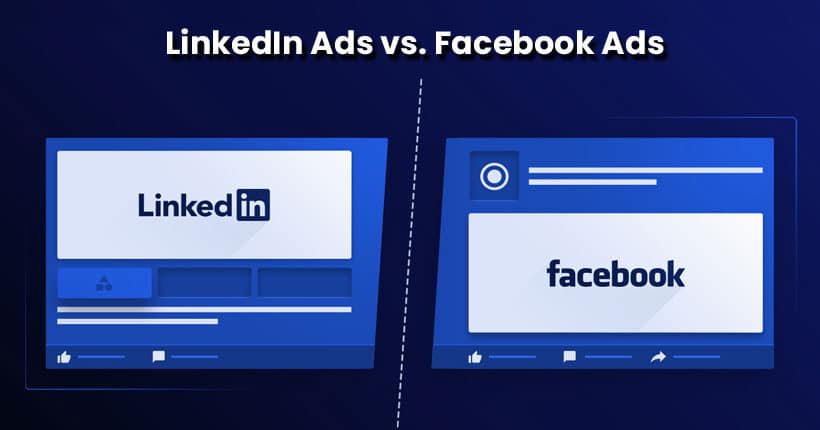As a digital marketer, you’ll continually face questions about which platform to use to propel your business forward.
Should the entire budget go towards Facebook ads? Are you doing enough on LinkedIn? These are the fundamental questions that plague the mind as you evaluate your growth marketing strategy. Here’s a quick comparison to help you make the right choice for your goals.
The Big Debate
Today, everyone knows the benefits of social media marketing. The sheer amount of social media channels available today can paralyze any business owner. Where to start? Most companies assume Facebook only because it has more users.
With over 2.2. Billion active users, it far exceeds LinkedIn’s 550 Million. Should size dictate which platform is better? Not necessarily.
Facebook and LinkedIn share similarities, different functionalities, and unique benefits. Unfortunately, there’s no straightforward answer because each scenario is unique to your business objectives.
By understanding what each platform offers, you’ll make the best decision when it comes to putting your money on the table.
-
Targeting:
Facebook is known for it’s targeting. While you have access to billions of users, you get to decide who you reach, ultimately serving your ads to those most likely to react.
You can target based on location, demographics, interests, behavior, and connections. You are taking it a step further with lookalike audiences and custom lists. The intricacies of Facebook’s targeting are unmatched, something that is incredibly appealing when it comes to sales-related content.
On the other hand, LinkedIn offers a more professional audience. The platform consists of users interested in networking, getting advice on career-related topics, and collaborating with like-minded people.
LinkedIn ads include account-based marketing allowing you to target professional demographics. Think about how much information you provide when signing up for LinkedIn. It’s essentially your entire professional history.
That’s why, as a basic rule of thumb, marketers use Facebook for B2C marketing, investing in LinkedIn if B2B is your priority.
-
Budgets:
Think about how much you want to spend on ads. Both Facebook and LinkedIn allow you to choose exactly how much you’ll pay, making them cost-effective solutions. The difference comes in when you look at the cost-per-click for each platform.
The average cost-per-click for LinkedIn ads is somewhere around $5.26, while Facebook’s CPC is $0.97. On paper, it would seem that Facebook is then the cheaper platform on which to advertise.
However, just because you pay less per click doesn’t mean you earn higher value leads. Lead generation with LinkedIn can be highly valuable. Although customers spend less time on LinkedIn, they’re in a conversion mindset when they are browsing.
-
Design:
If your brand is focused heavily on aesthetics and visual identity, Facebook offers a broader variety.
Facebook ad formats include:
- Photo link ads
- Video ads
- Instant Experiences
- Story ads
- Carousel ads
- Messenger ads
LinkedIn offers less visual elements, delivering more text formats like:
- Display ads
- Sponsored content
- Sponsored InMail
- Text ads
- Dynamic ads
Depending on your marketing objectives and the product you’re selling, you’ll be able to decide where to place your focus; text or design.
-
Analytics:
LinkedIn Analytics is delivered in three sections:
- Updates: Includes your audience, impressions, clicks, interactions, followers acquired, and engagement statistics.
- Followers: Organic and acquired following along with follower demographics and trends over time
- Visitors: Pageviews, career page clicks, unique visitors, and visitor demographics.
Facebook delivers a similar set of analytics through Page Insights.
- Overview: page likes, post reach, and engagement
- Likes: page and net likes
- Reach: Post reach, positive and negative engagement, and total reach
- Visits: Page and tab visits
- Posts: Post types and best performing content
- Video: Video views, 30-second views, and top video performance
- People: Your fans, people reached, and people engaged
-
Groups:
Both LinkedIn and Facebook offer a group feature, essential tools when it comes to connecting with prospects. Whether it’s networking opportunities or sales content, groups are a useful way to bring people together.
It’s critical to consider people’s motives when they’re on either platform. Think about the mindset you’re in when joining a group on Facebook or when you’re joining one on LinkedIn. While you may engage on both, you’ll do so for different reasons.
Facebook groups tend to be more personal. They’re usually related to lifestyle, politics, or hobbies. LinkedIn groups are focused on work, bringing like-minded professionals together. Again, your objectives dictate the platform you choose.
Who wins?
Both platforms provide a diverse range of opportunities for you and your business needs. The important thing is defining what you want out of your ads. While the media share similar offerings, there is a fundamental difference in their audience.
Before you invest in either channel, spend some time defining who you’re talking to and why. There are opportunities for growth on either side of the spectrum. It’s about defining the channel with the most significant ROI for your company.


